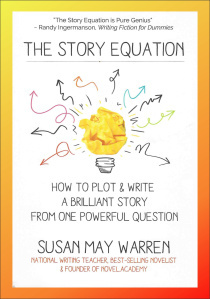Warren Writes to Grow Characters
 Susan May Warren. 2016. The Story Equation. Minneapolis: My Book Therapy.
Susan May Warren. 2016. The Story Equation. Minneapolis: My Book Therapy.
Review by Stephen W. Hiemstra
What makes the character in a novel come to life? Why do some readers behave like crack addicts whose lives are consumed in reading? Why are some writers obsessed with feeding this addiction, like wantabe drug pushers, and, in the process, finding fame and fortune? While these groups encompass a lot of people, my own interest is more personal—as I write my own memoir, how am I to understand my own character development? These questions brought me to Susan Warren’s book, The Story Equation.
Warren writes:
“How well your readers connect with and care about this character determines the success of a story. In other words, if they’re emotionally gone on the journey with the character, suffered with and experienced the joys and triumphs of the character, as well as learned the lessons and truths, only then have you, the author, done your job.” (10)
She calls her method for accomplishing and maintaining this connection the Story Equation (13), which she describes as a multi-tier recipe (33-34). Her emphasis on the inner journey rather than the outer journey of her characters (plot) helps place her method in the genre of inspirational fiction.
In broad strokes, Warren sees a story having four acts, each with its own emotional purpose, which she describes as a character change journey (16).
In act 1, the main character is introduced and confronted with an inciting incident. She writes: “your key job is to help readers identify with the character, feel his journey, and triumph with him” (19). The character’s biography should be revealed through stories illustrating who he is, not described as in a resume which would slow the action (20-21). The inciting incident challenges the character both to step out of his normal routine and to grow out of previous mindset.
In act 2, our character meets obstacles that must be overcome; otherwise, the story dies as our hero melts before the challenge. Warren calls the motivation to rise and overcome the obstacles a noble quest (23).
In act 3, our character must fight to overcome both internal and external obstacles (25). Warren writes:
“at that moment we are forced to confront the lies we believe, our broken behaviors (flaws), and our fears. This is called the Black Moment Effect … [and] we see the truth.” (26)
This Black Moment Effect is critical in inspirational plot development because the character must see that to triumph, he must sacrifice to overcome the lie that has held him back—the person he was must die in order for him to move forward and both become a new person and triumph against his obstacles (27).
In act 4, we witness the character’s triumph. To prove that the character has changed, he must “make a Grand Gesture, sacrifice something, engage in a Final Battle” (28). Because change in our own lives is so difficult, it can be no less complicated or dramatic for our characters. The whole point of an inspirational novel, however, is to show that change is, in fact, possible but it cannot happen without sacrifice (27).
In case you thought writing inspirational fiction was easy and straightforward, Warren makes two more passes through these four acts. In the first pass, the focus is on the internal journey; in the second pass the focus shifts to the external story (plot) structure; in the third pass the focus shifts to how the internal and the external story relate to one another. Warren refers to this second pass as the Story Equation, which she defines with an acronym (LINDY HOP); she refers third pass as the character change journey. Clearly, it would take a small book to explain her approach adequately, even in a review.
Susan May Warren grew up in Wayzata, Minnesota, studied Mass Communications at the University of Minnesota, and spent eight years working in missions in Siberia, Russia. She is the author of numerous books and works as a writing coach. She is also a great speaker and very approachable person.
Susan May Warren’s The Story Equation is an intriguing book—easy to read, but worthy of deep reflection. Reading this book, I found myself repeatedly adding new chapters to my memoir writing project, as I reflected on my own life’s journey. Her insights into the human condition are profound, leaving me curious to read more of her work. She is also supremely readable, illustrating her points on character development with examples taken from famous movies, such the internal life of Benjamin Martin who was played by Mel Gilson in the film, The Patriot. Authors take note—this is a helpful book to read, even if you are like me and focus on nonfiction.
http://www.SusanMayWarren.com, http://www.MyBookTherapy.com, and http://www.LearnHowtoWriteaNovel.com.
Because stories are typically said to have three acts, she divides act 2 into two parts: 2A and 2B. For simplicity’s sake, I stick with four acts in this review.
LINDY HOP = Life, Inciting incident, Noble quest, Disappointments, Y in the road, Help, Overhaul, and Perfect ending.
When I was an undergraduate at Iowa State University in Ames, Iowa, the graduate school at University of Minnesota tried to recruit me at one point but I told them it was cold enough in Ames! Later I regretted turning them down, because it was a great school.
For a list of books, either check with Amazon.com or visit her official website, cited earlier.
I met Susan at a conference sponsored by the American Christian Fiction Writers fellowship in Woodbridge, Virginia on October 22, 2016.





